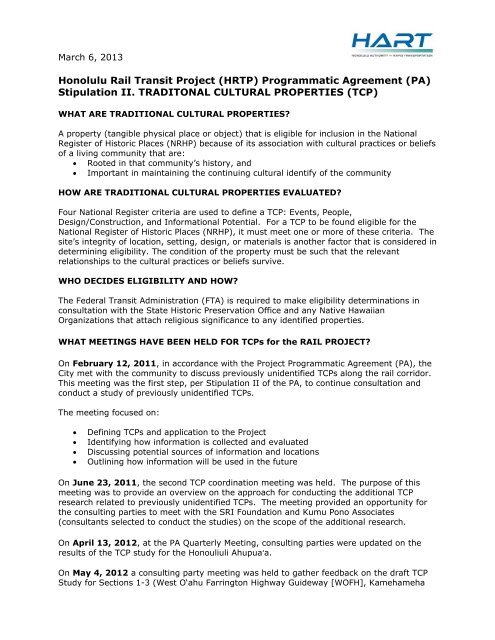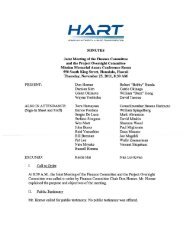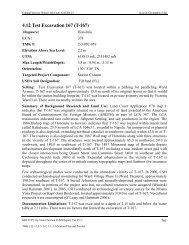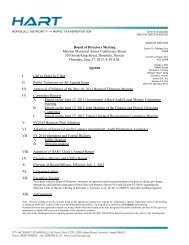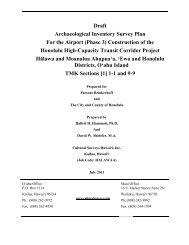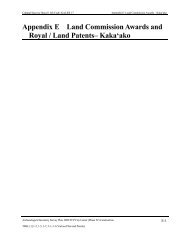Download - Honolulu Rail Transit Project
Download - Honolulu Rail Transit Project
Download - Honolulu Rail Transit Project
You also want an ePaper? Increase the reach of your titles
YUMPU automatically turns print PDFs into web optimized ePapers that Google loves.
March 6, 2013<br />
<strong>Honolulu</strong> <strong>Rail</strong> <strong>Transit</strong> <strong>Project</strong> (HRTP) Programmatic Agreement (PA)<br />
Stipulation II. TRADITONAL CULTURAL PROPERTIES (TCP)<br />
WHAT ARE TRADITIONAL CULTURAL PROPERTIES?<br />
A property (tangible physical place or object) that is eligible for inclusion in the National<br />
Register of Historic Places (NRHP) because of its association with cultural practices or beliefs<br />
of a living community that are:<br />
Rooted in that community’s history, and<br />
Important in maintaining the continuing cultural identify of the community<br />
HOW ARE TRADITIONAL CULTURAL PROPERTIES EVALUATED?<br />
Four National Register criteria are used to define a TCP: Events, People,<br />
Design/Construction, and Informational Potential. For a TCP to be found eligible for the<br />
National Register of Historic Places (NRHP), it must meet one or more of these criteria. The<br />
site’s integrity of location, setting, design, or materials is another factor that is considered in<br />
determining eligibility. The condition of the property must be such that the relevant<br />
relationships to the cultural practices or beliefs survive.<br />
WHO DECIDES ELIGIBILITY AND HOW?<br />
The Federal <strong>Transit</strong> Administration (FTA) is required to make eligibility determinations in<br />
consultation with the State Historic Preservation Office and any Native Hawaiian<br />
Organizations that attach religious significance to any identified properties.<br />
WHAT MEETINGS HAVE BEEN HELD FOR TCPs for the RAIL PROJECT?<br />
On February 12, 2011, in accordance with the <strong>Project</strong> Programmatic Agreement (PA), the<br />
City met with the community to discuss previously unidentified TCPs along the rail corridor.<br />
This meeting was the first step, per Stipulation II of the PA, to continue consultation and<br />
conduct a study of previously unidentified TCPs.<br />
The meeting focused on:<br />
<br />
<br />
<br />
<br />
Defining TCPs and application to the <strong>Project</strong><br />
Identifying how information is collected and evaluated<br />
Discussing potential sources of information and locations<br />
Outlining how information will be used in the future<br />
On June 23, 2011, the second TCP coordination meeting was held. The purpose of this<br />
meeting was to provide an overview on the approach for conducting the additional TCP<br />
research related to previously unidentified TCPs. The meeting provided an opportunity for<br />
the consulting parties to meet with the SRI Foundation and Kumu Pono Associates<br />
(consultants selected to conduct the studies) on the scope of the additional research.<br />
On April 13, 2012, at the PA Quarterly Meeting, consulting parties were updated on the<br />
results of the TCP study for the Honouliuli Ahupua‘a.<br />
On May 4, 2012 a consulting party meeting was held to gather feedback on the draft TCP<br />
Study for Sections 1-3 (West O‘ahu Farrington Highway Guideway [WOFH], Kamehameha
HART – March 6, 2013, Page 2<br />
Highway Guideway [KHG] and Airport Guideway) that included a Draft TCP Management<br />
Summary and Technical Report. These documents were made available on April 20, 2012<br />
to the consulting parties.<br />
WHAT REPORTS ARE AVAILABLE?<br />
These reports are available under the Planning tab, II. Traditional Cultural Properties on the<br />
project website: honolulutransit.org.<br />
TCP Report for Honouliuli Ahupua‘a (03.01.2012). Study to Identify the Presence of<br />
Previously Unidentified Traditional Cultural Properties (TCP) in the Honouliuli Ahupua‘a for<br />
the <strong>Honolulu</strong> <strong>Rail</strong> <strong>Transit</strong> <strong>Project</strong><br />
Draft TCP Study for WOFH, KHG and Airport (04.20.2012). Draft Report - Study to<br />
Identify the Presence of Previously Unidentified Traditional Cultural Properties (TCP) in<br />
Sections 1-3 (West Oahu Farrington Highway, Kamehameha Highway Guideway and Airport)<br />
for the <strong>Honolulu</strong> <strong>Rail</strong> <strong>Transit</strong> <strong>Project</strong> - Management Summary (Preliminary Draft TCP Study<br />
for WOFH, KHG and Airport dated March 26, 2012, was superseded by the report dated April<br />
20, 2012 above)<br />
TCP Study Technical Report (04.21.2012) He Moolelo Aina-Traditions and Storied Places<br />
in the District of Ewa and Moanalua (in the District of Kona), Island of Oahu: A Traditional<br />
Cultural Properties Study-Technical Report. (Draft TCP Technical Report dated January 20,<br />
2012, which is superseded by the report dated April 21, 2012 above)<br />
Determination of Eligibility and Finding of Effect for Previously Unidentified TCPs<br />
in Sections 1-3 (05.25.2012) Determination of Eligibility and Finding of Effect (DOEFOE)<br />
for Previously Unidentified Traditional Cultural Properties (TCPs) in Sections 1 (West<br />
Oahu/Farrington Highway), 2 (Kamehameha Highway Guideway) and 3 (Airport)<br />
WHAT DID THE TCP STUDIES FOR SECTIONS 1-3 CONCLUDE?<br />
The FTA requested and received SHPD concurrence with the determination of eligibility and<br />
finding of effect for previously unidentified Traditional Cultural Properties in HRTP Sections<br />
1-3 for 13 ahupua‘a, 26 wahi pana (sacred or storied places), 1 Leina a ka ‘uhane and 10<br />
inoa‘ āina (named places).<br />
Of these 50 resources, the 13 ahupua‘a (including Honouliuli) were not further evaluated for<br />
eligibility since they are the larger traditional land divisions for the island of O‘ahu that<br />
provide the context for consideration of individual wahi pana. This left 37 sites for further<br />
consideration. Fifteen of these sites were determined to be outside the area of potential<br />
effect. Twenty were determined not eligible for inclusion on the National Register of Historic<br />
Places (NRHP), and 2 were determined eligible. A Finding of No Adverse Effect was made<br />
for the two historic properties. The two sites are:<br />
Huewaipī – This site is the location of inter-related springs, wetlands and lo‘i,<br />
and takes its significance from traditional agricultural practices and<br />
Kūki‘iahu (Kūki‘i) - This site is situated in the same area as the Sumida<br />
Watercress Farm and is eligible as part of the larger Sumida Watercress Farm<br />
identified as a historic property in previous studies.<br />
WHAT OTHER CULTURAL RESOURCES WERE STUDIED?<br />
Previous studies that addressed resources that met the definition of potential Traditional<br />
Cultural Properties are available on the HRTP website. These prior studies identified historic
HART – March 6, 2013, Page 3<br />
properties found eligible, in part, because of the role the properties play in a community's<br />
historically rooted beliefs, customs, and practices. These include, but are not limited to:<br />
Sumida Watercress Farm (associated with the history of wetland agriculture), Aiea<br />
Plantation Cemetery (associated with the plantation settlement pattern), the 1958 Kamaka<br />
Ukulele Building (associated with the development of ukulele music in Hawaiian culture), the<br />
Tong Fat Building (a focal point for the ‘A‘ala neighborhood), and the 1963 Waipahu Stake<br />
of the Church of Jesus Christ of Latter Day Saints (associated with the Samoan community).<br />
Table 4-34 of the Final Environmental Impact Statement identifies No Adverse Effect by the<br />
<strong>Project</strong> to these properties.<br />
Prior relevant technical reports (available on the project website by searching for the report<br />
name) are:<br />
<br />
<br />
<br />
<br />
<br />
<br />
Cultural Resources Technical Report, <strong>Honolulu</strong> High-Capacity <strong>Transit</strong> Corridor <strong>Project</strong>,<br />
August 15, 2008<br />
Cultural Resources Technical Report Addendum 01, <strong>Honolulu</strong> High-Capacity <strong>Transit</strong><br />
Corridor <strong>Project</strong>, May 22, 2009<br />
Historic Resources Technical Report, <strong>Honolulu</strong> High-Capacity <strong>Transit</strong> Corridor <strong>Project</strong>,<br />
August 15, 2008<br />
Addendum 01 to the Historic Resources Technical Report, <strong>Honolulu</strong> High-Capacity <strong>Transit</strong><br />
Corridor <strong>Project</strong>, June 7, 2010<br />
Draft Historic and Archaeological Technical Report, <strong>Honolulu</strong> High-Capacity <strong>Transit</strong><br />
Corridor <strong>Project</strong>, September 1, 2006<br />
Archaeological Resources Technical Report, <strong>Honolulu</strong> High-Capacity <strong>Transit</strong> Corridor<br />
<strong>Project</strong>, August 15, 2008<br />
WHEN WILL THE TCP STUDY ON CITY CENTER SECTION BE AVAILABLE FOR<br />
REVIEW?<br />
City Center TCP Technical Report and Management Summary are expected to be available<br />
for consulting party review in Spring 2013. An opportunity to meet with Kumu Pono (Kepa<br />
Maly) will be scheduled.


